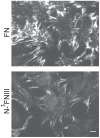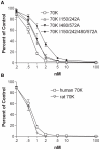IGD motifs, which are required for migration stimulatory activity of fibronectin type I modules, do not mediate binding in matrix assembly
- PMID: 22355321
- PMCID: PMC3280255
- DOI: 10.1371/journal.pone.0030615
IGD motifs, which are required for migration stimulatory activity of fibronectin type I modules, do not mediate binding in matrix assembly
Abstract
Picomolar concentrations of proteins comprising only the N-terminal 70-kDa region (70K) of fibronectin (FN) stimulate cell migration into collagen gels. The Ile-Gly-Asp (IGD) motifs in four of the nine FN type 1 (FNI) modules in 70K are important for such migratory stimulating activity. The 70K region mediates binding of nanomolar concentrations of intact FN to cell-surface sites where FN is assembled. Using baculovirus, we expressed wildtype 70K and 70K with Ile-to-Ala mutations in (3)FNI and (5)FNI; (7)FNI and (9)FNI; or (3)FNI, (5)FNI, (7)FNI, and (9)FNI. Wildtype 70K and 70K with Ile-to-Ala mutations were equally active in binding to assembly sites of FN-null fibroblasts. This finding indicates that IGD motifs do not mediate the interaction between 70K and the cell-surface that is important for FN assembly. Further, FN fragment N-(3)FNIII, which does not stimulate migration, binds to assembly sites on FN-null fibroblast. The Ile-to-Ala mutations had effects on the structure of FNI modules as evidenced by decreases in abilities of 70K with Ile-to-Ala mutations to bind to monoclonal antibody 5C3, which recognizes an epitope in (9)FNI, or to bind to FUD, a polypeptide based on the F1 adhesin of Streptococcus pyogenes that interacts with 70K by the β-zipper mechanism. These results suggest that the picomolar interactions of 70K with cells that stimulate cell migration require different conformations of FNI modules than the nanomolar interactions required for assembly.
Conflict of interest statement
Figures





Similar articles
-
Extended binding site on fibronectin for the functional upstream domain of protein F1 of Streptococcus pyogenes.J Biol Chem. 2010 Dec 24;285(52):41087-99. doi: 10.1074/jbc.M110.153692. Epub 2010 Oct 13. J Biol Chem. 2010. PMID: 20947497 Free PMC article.
-
Ligation of the fibrin-binding domain by β-strand addition is sufficient for expansion of soluble fibronectin.J Biol Chem. 2012 Apr 13;287(16):13303-12. doi: 10.1074/jbc.M111.294041. Epub 2012 Feb 20. J Biol Chem. 2012. PMID: 22351755 Free PMC article.
-
Multi-factorial modulation of IGD motogenic potential in MSF (migration stimulating factor).Exp Cell Res. 2010 Sep 10;316(15):2465-76. doi: 10.1016/j.yexcr.2010.04.003. Epub 2010 Apr 18. Exp Cell Res. 2010. PMID: 20403349
-
Pleiotropic virulence factor - Streptococcus pyogenes fibronectin-binding proteins.Cell Microbiol. 2013 Apr;15(4):503-11. doi: 10.1111/cmi.12083. Epub 2012 Dec 20. Cell Microbiol. 2013. PMID: 23190012 Review.
-
Proteins F1 and F2 of Streptococcus pyogenes. Properties of fibronectin binding.Adv Exp Med Biol. 1996;408:141-50. doi: 10.1007/978-1-4613-0415-9_16. Adv Exp Med Biol. 1996. PMID: 8895786 Review. No abstract available.
Cited by
-
Emergence of a Thrombospondin Superfamily at the Origin of Metazoans.Mol Biol Evol. 2019 Jun 1;36(6):1220-1238. doi: 10.1093/molbev/msz060. Mol Biol Evol. 2019. PMID: 30863851 Free PMC article.
-
Dynamic structure of plasma fibronectin.Crit Rev Biochem Mol Biol. 2015 Jul-Aug;51(4):213-27. doi: 10.1080/10409238.2016.1184224. Epub 2016 May 17. Crit Rev Biochem Mol Biol. 2015. PMID: 27185500 Free PMC article. Review.
-
The in vitro analysis of migration and polarity of blastema cells in the extracellular matrix derived from bovine mesenteric in the presence of fibronectin.Anat Cell Biol. 2022 Jun 30;55(2):229-238. doi: 10.5115/acb.21.233. Epub 2022 Jun 7. Anat Cell Biol. 2022. PMID: 35668476 Free PMC article.
References
-
- George EL, Georges-Labouesse EN, Patel-King RS, Rayburn H, Hynes RO. Defects in mesoderm, neural tube and vascular development in mouse embryos lacking fibronectin. Development. 1993;119:1079–1091. - PubMed
-
- Pankov R, Yamada KM. Fibronectin at a glance. J Cell Sci. 2002;115:3861–3863. - PubMed
-
- Zerlauth G, Wolf G. Plasma fibronectin as a marker for cancer and other diseases. Am J Med. 1984;77:685–689. - PubMed
-
- Cho J, Mosher DF. Role of fibronectin assembly in platelet thrombus formation. J Thromb Haemost. 2006;4:1461–1469. - PubMed
Publication types
MeSH terms
Substances
Grants and funding
LinkOut - more resources
Full Text Sources
Miscellaneous

